On making homemade yogurt
I eat yogurt.
No, like, I eat a lot of yogurt. Enough yogurt that I'd certainly consider myself to be a yogurt aficionado. I have graduated from Yoplait -- long since. The next stop for many is Chobani, the fat-free, watery mess that it is. I've graduated from that, too. I liked Fage yogurt for a while, until it got difficult to find full-fat flavored Fage -- there were too many options on the shelf and it just took too much time to find the ones I wanted. A year or so ago, I discovered that I enjoyed of Noosa, "Australian-style yoghurt", which comes in delightful 200kcal-ish tubs, and seems to be just the right consistency to make me happy. And, the only variance of Noosa tubs is in flavor; they're all the same yogurt base.
But recently, I've moved along again, to a new type of yogurt. A few months ago, I found Siggi's Icelandic-style Skyr. I've been eating the nice little 110kcal tubs as a nice compliment to breakfast and dinner. They're expensive -- around $1.69 for a tub. But, it's very tasty, and it doesn't have all the sugar that Noosa has (the vanilla type has only 9g of sugar). To be honest, I think it's my new yogurt of preference.
But now, I think it might be time to take it one step further. If buying yogurt is good, then how hard can it be to make yogurt? People seem to do it; could I come up with a reproducible recipe, and use science on it?
The following is how I did it. The results were good!
No, like, I eat a lot of yogurt. Enough yogurt that I'd certainly consider myself to be a yogurt aficionado. I have graduated from Yoplait -- long since. The next stop for many is Chobani, the fat-free, watery mess that it is. I've graduated from that, too. I liked Fage yogurt for a while, until it got difficult to find full-fat flavored Fage -- there were too many options on the shelf and it just took too much time to find the ones I wanted. A year or so ago, I discovered that I enjoyed of Noosa, "Australian-style yoghurt", which comes in delightful 200kcal-ish tubs, and seems to be just the right consistency to make me happy. And, the only variance of Noosa tubs is in flavor; they're all the same yogurt base.
But recently, I've moved along again, to a new type of yogurt. A few months ago, I found Siggi's Icelandic-style Skyr. I've been eating the nice little 110kcal tubs as a nice compliment to breakfast and dinner. They're expensive -- around $1.69 for a tub. But, it's very tasty, and it doesn't have all the sugar that Noosa has (the vanilla type has only 9g of sugar). To be honest, I think it's my new yogurt of preference.
But now, I think it might be time to take it one step further. If buying yogurt is good, then how hard can it be to make yogurt? People seem to do it; could I come up with a reproducible recipe, and use science on it?
The following is how I did it. The results were good!
April 2016
Joshua Wise; CC BY-SA 3.0
(click for big)
You will need:
A gallon of milk;
(non-organic; see below)
Some unflavored yogurt that you want to Xerox;
A science cookware set full of
science.
(i.e., a sous-vide machine)
I started off with a gallon of 2% milk, picked up from Safeway. Skyr is
traditionally made with skim milk (ok, well, traditionally it's made
with raw milk, but apparently these days it is made with skim), but Siggi's
also makes some "Rjóma-skyr" out of 2% or full-fat milk, and I quite
like it. Anyway, I didn't buy any kind of special milk -- certainly not
organic (or UHT
milk, which is what I'd otherwise buy to keep around the house), since UHT
processing changes the structure of milk, apparently. Just a plain old
cheapo gallon of 2%.
I stuck it in a stockpot, and began the most finicky part of the operation. Make sure everything is clean, since the goal is to grow bacteria here. This includes the milk, so the goal is to raise the temperature of the milk to 190°F for half an hour or so. In practice, this took me about an hour of screwing around with the stove, and trying to get the heat exactly right. A Thermapen helps a lot. Keep stirring, and try not to scorch the milk. I did. I think if I were going to do this again, I'd consider using the sous-vide circulator for this step, too. If it develops a skin, take the skin off the top or just stir it back in.
Eventually, you will have decided that your milk is appropriately sterilized, and the next goal is to reduce the milk's temperature to the desired fermentation temperature. I filled the bath for the immersion circulator with water from the tap as cold as I could get it, and then dropped the stockpot into the bath (lid on!), and finally plugged the circulator in and told it to begin circulating without heat. A probe with the Thermapen told me that I got basically exactly to the 110°F that I was aiming for.
I separated out a dishful of warm milk, opened a small thing of Siggi's vanilla, and stirred in about a spoonful into the dish, making sure it was fully dissolved. Then, I stirred the dish into my stockpot, covered it, and set the Sansaire for 110°F.
Then, I ate the rest of the thing of Siggi's, and went to bed.
I stuck it in a stockpot, and began the most finicky part of the operation. Make sure everything is clean, since the goal is to grow bacteria here. This includes the milk, so the goal is to raise the temperature of the milk to 190°F for half an hour or so. In practice, this took me about an hour of screwing around with the stove, and trying to get the heat exactly right. A Thermapen helps a lot. Keep stirring, and try not to scorch the milk. I did. I think if I were going to do this again, I'd consider using the sous-vide circulator for this step, too. If it develops a skin, take the skin off the top or just stir it back in.
Eventually, you will have decided that your milk is appropriately sterilized, and the next goal is to reduce the milk's temperature to the desired fermentation temperature. I filled the bath for the immersion circulator with water from the tap as cold as I could get it, and then dropped the stockpot into the bath (lid on!), and finally plugged the circulator in and told it to begin circulating without heat. A probe with the Thermapen told me that I got basically exactly to the 110°F that I was aiming for.
I separated out a dishful of warm milk, opened a small thing of Siggi's vanilla, and stirred in about a spoonful into the dish, making sure it was fully dissolved. Then, I stirred the dish into my stockpot, covered it, and set the Sansaire for 110°F.
Then, I ate the rest of the thing of Siggi's, and went to bed.
In the morning, it was apparent that a nice curd had set up; it had, at
least, pulled away from the side of the pot. It still
smelled like warm milk, which by this point was kind of unpleasantly sweet.
It was a perfectly enjoyable smell when the milk was on the stove earlier,
but enough was enough by now. A scorched bit of milk had floated up to the
top. Oh well. It did also smell some like yogurt, though.
For those keeping track, this was about 11 hours at 110°F.
For those keeping track, this was about 11 hours at 110°F.
The next operation is to strain it. A colander lined one- or two-deep with
cheesecloth did the trick. Ladling it out was a somewhat messy operation;
be careful not to ladle scorched milk from the bottom. Structural integrity
of the curd was not terribly high, and there was a good amount of whey
(liquid) already. Some people like un-strained yogurt. Not me.
After it had been migrated to its new temporary home, into the fridge it went.
After it had been migrated to its new temporary home, into the fridge it went.
Nine hours later, it strained quite a lot! I tasted it in the middle, and
it still tasted too sweet and milky, and was pretty watery. But this stuff
now had the right consistency, too -- it held its shape very well. In fact,
when I inverted it into a bowl, the cheesecloth still left its mark on the
outside.
Please excuse my Nexus 5X's poor excuse for white balance here. It actually
is more white than butter-colored. In the end, I had strained out about
two-ish quarts of whey, and stuck those in the freezer for use later.
Apparently whey can be used for all sorts of stuff.
Serving suggestion. I was pleasantly surprised with the flavor, especially
given what I had tasted earlier. Not as acidic as I would have thought, or
even maybe as I might have hoped for; the flavor may develop over a few days
in the fridge. It tastes surprisingly like skyr! It is pretty mild, in
general. Half an hour after eating it, it still seems to linger on the
palate a bit more than I expect. On the other hand, it was much thicker
than I thought I could get by straining myself (and especially given that I
made it without rennet).
I think this would work especially well in smoothies. Eating it straight is not bad either.
So I think the conclusion is: not bad for a first try, and maybe even not bad, full stop. It's not as hard as I thought it was; the biggest pain-in-the-ass factor was sterilizing the milk without scorching it. I expected it to be much more finicky of an operation in general, and I expected to basically have to throw away a few batches to tweak the parameters some; that's eminently not true.
Anyway, I recommend it! Give it a try, and let me know how yours turns out.
I think this would work especially well in smoothies. Eating it straight is not bad either.
So I think the conclusion is: not bad for a first try, and maybe even not bad, full stop. It's not as hard as I thought it was; the biggest pain-in-the-ass factor was sterilizing the milk without scorching it. I expected it to be much more finicky of an operation in general, and I expected to basically have to throw away a few batches to tweak the parameters some; that's eminently not true.
Anyway, I recommend it! Give it a try, and let me know how yours turns out.
Joshua Wise, 2016
No, I have not gotten food poisoning yet. Check back in 24 hours.
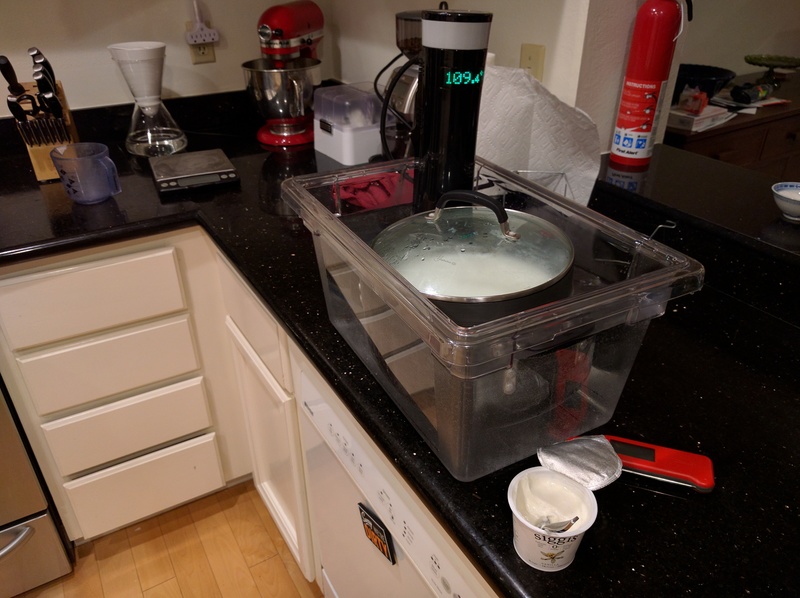
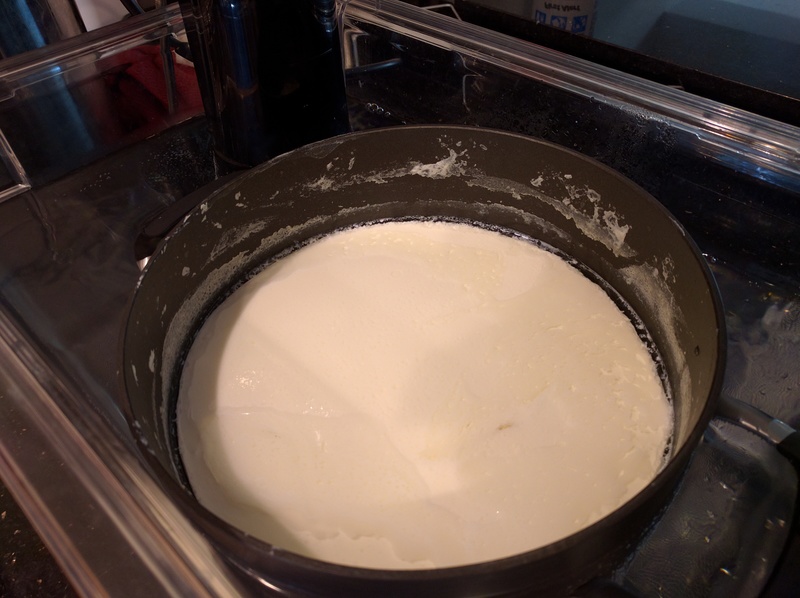
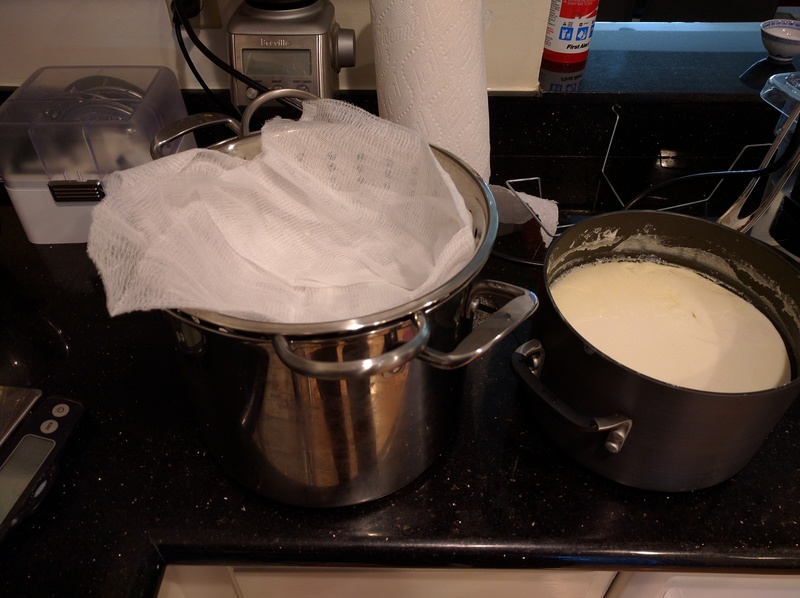
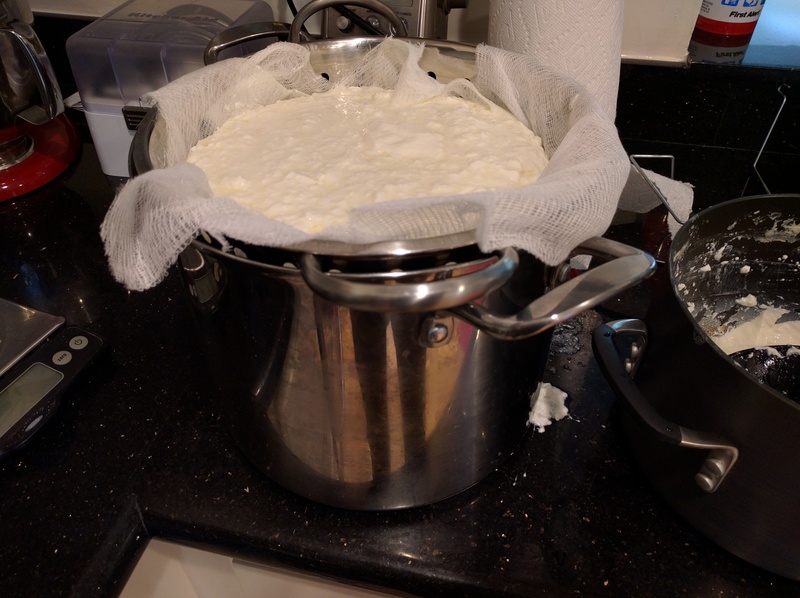
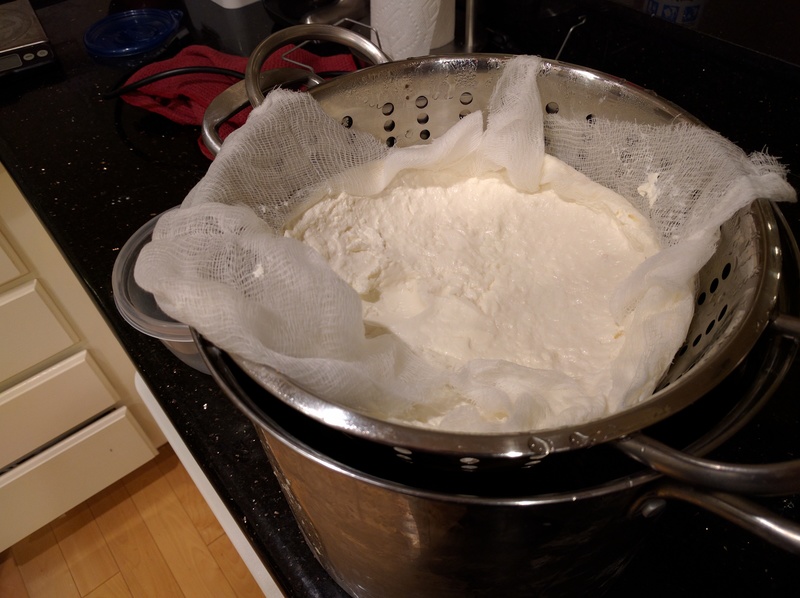
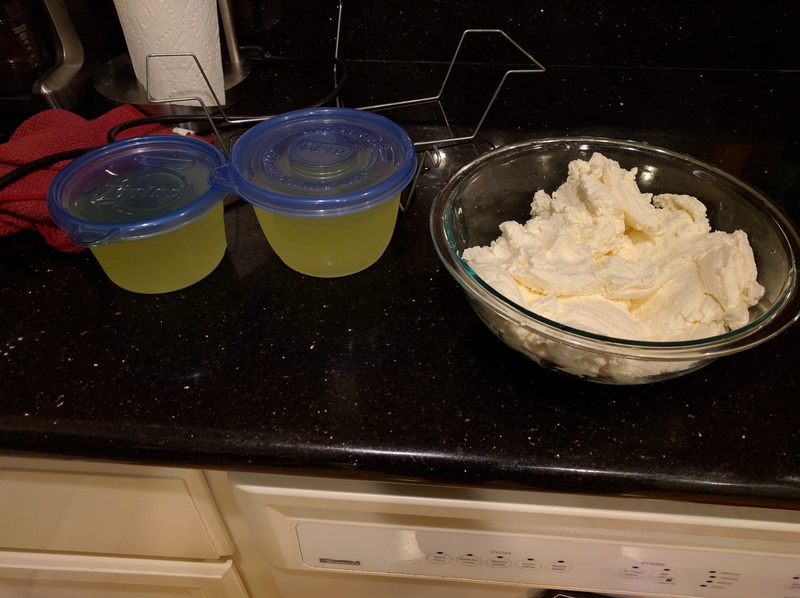
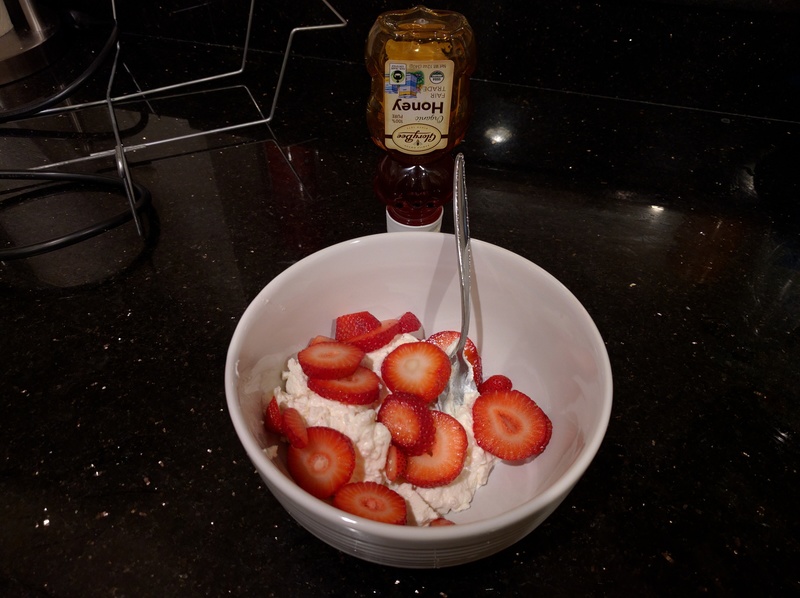
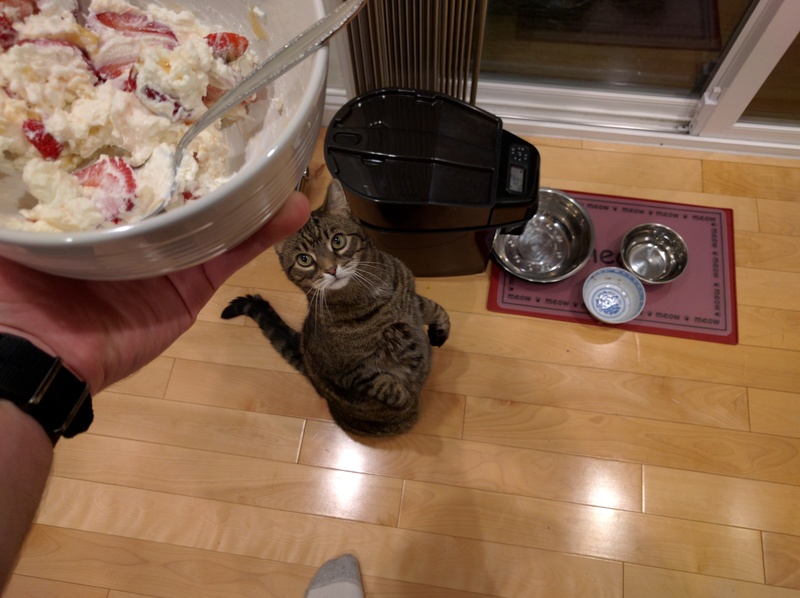
He doesn't understand that cats are lactose intolerant.
He got a fingerful anyway, for this nice performance.
(This is what we call 'rewarding bad behavior'.)